

Want to Be a Better Problem-Solver and Opportunity-Finder? Strategic Design Thinking Holds the Key. Design Thinking and PBL. While project-based learning has existed for decades, design thinking has recently entered the education lexicon, even though its history can be traced back to Herbert A.
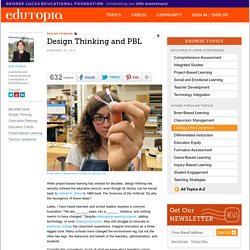
Simon's 1969 book The Sciences of the Artificial. So why the resurgence of these ideas? Lately, I have heard teachers and school leaders express a common frustration: "We are _______ years into a _______ initiative, and nothing seems to have changed. " Despite redesigning learning spaces, adding technology, or even flipping instruction, they still struggle to innovate or positively change the classroom experience. Imagine innovation as a three-legged stool. Consider this conundrum: much of what we know about teaching comes from 16+ years of observation as students. If we look at the science of improvement, systematic change occurs between the contexts of justification (what we know) and discovery (the process of innovation). PBL and 21st-Century Skills. How to Bring Design Thinking to Your School for Free (Without Hiring a Fancy Consultant)
It’s time for another rousing edition of “Because You Asked,” a space for you to ask those questions weighing you down--the ones you don't even want to ask your friends.
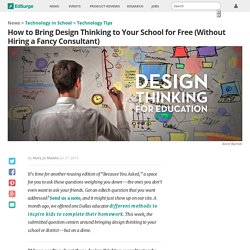
Got an edtech question that you want addressed? Send us a note, and it might just show up on our site. Design Thinking and PBL. Design Thinking in Education: Empathy, Challenge, Discovery, and Sharing. "Design thinking gave me a process to weave through all of the project–based learning experiences I create with my kiddos.
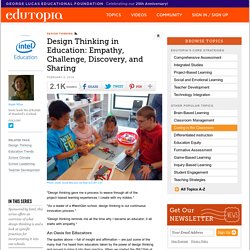
" "As a leader of a #NextGen school, design thinking is our continuous innovation process. " "Design thinking reminds me all the time why I became an educator; it all starts with empathy. " An Oasis for Educators The quotes above -- full of insight and affirmation -- are just some of the many that I've heard from educators taken by the power of design thinking and moved to bring it into their practice.
When we started the @K12lab at Stanford's d.school back in 2007 we began with a hunch that design thinking would be a great tool for educators to deploy in their classrooms and schools, and that ultimately, it would be a useful process for kids working through interdisciplinary challenges. In the last few years, the field has witnessed an explosion of interest in design thinking, nationally and internationally. Uk.businessinsider. How Might We the Content?: Applying Design Thinking in a High School English Classroom. EMPATHIZE.
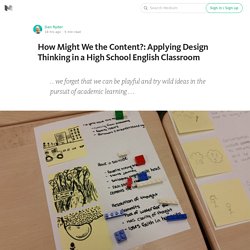
And here we identify the point of view of the users involved. Those users might be readers of essays and stories or the audience of speeches, presentation and debates. They might also be the characters in a novel or the speaker of a poem. Writing as an act of problem-solving begins with the basic premise that a writer is a designer, so long as one considers the act of writing an audience-centered experience rather than an author-centered one. When we write for ourselves, we our meeting our own needs. Reading as an act of problem solving begins with the basic premise that the subject of the text — whether protagonist or antagonist, fictional or non — has been placed in those circumstances, on that page, with intention on the part of the author. How Design Thinking Improves the Creative Process. It’s not just IDEO implementing design thinking into everyday work.
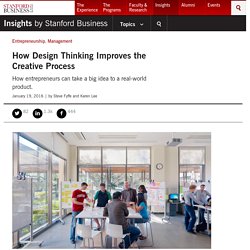
More companies are turning to this problem-solving approach, which focuses on customer challenges to improve anything from the design of a water bottle to the design of a community water system. We recently talked to Stefanos Zenios, a professor of operations, information, and technology at Stanford GSB, on how to get customer feedback, create effective prototypes, and facilitate more productive brainstorming sessions through design thinking.
7 Tools for Design Thinking. We’ve had a makeover.

If you’re using the WE THINQ interface you’ll notice we’ve added a little pizzazz to our tool for the new year. Not only is the social innovation process laid out more clearly, we’ve also given you the option to work on your project using the design thinking process. The design thinking process differs from traditional forms of open innovation. But as that is a definition that is ever changing we are excited to be giving you the options to choose the best method for the project at hand. WE THINQ interface - The perfect place to start your project. Design Thinking Comes To Kids In This Cute Board Game.
Design Thinking 1 - Empathize - Excellence Blog. As we have uncovered more about play we thought it was time for the children to have an opportunity to demonstrate their learning in a hands-on way.
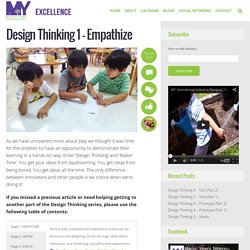
Enter ‘Design Thinking’ and ‘Maker Time’. You get your ideas from daydreaming. You get ideas from being bored. You get ideas all the time. The only difference between innovators and other people is we notice when we’re doing it! What Does ‘Design Thinking’ Look Like in School? Getty Images Design thinking can seem a bit abstract to teachers.
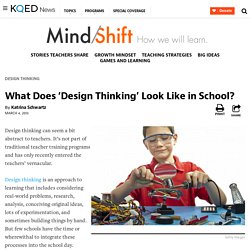
It’s not part of traditional teacher training programs and has only recently entered the teachers’ vernacular. Design thinking is an approach to learning that includes considering real-world problems, research, analysis, conceiving original ideas, lots of experimentation, and sometimes building things by hand. But few schools have the time or wherewithal to integrate these processes into the school day. But at the Nueva School in Hillsborough, Calif., a small, private school for grades K-8, design thinking is part of every class and subject, and has been integrated throughout the curriculum with support from a dedicated Innovation Lab or the iLab. How to Apply Design Thinking in Class, Step By Step. By Anne Stevens For educators ready to try the idea of design thinking, you’ll be glad to know it does not require extensive transformation of your classroom. That said, it can be a transformative experience for all involved. Here, we try to answer your questions about integrating different components of a design learning experience into familiar, pre-existing scenarios that play out in every school.
Can my classroom become a space of possibility? For students, the best classroom experience is a space of possibility. Design Thinking, Deconstructed. Can Design Thinking Help Schools Find New Solutions to Old Problems? Principal Kamar Samuels had a problem: how to reach the most disaffected students at Bronx Writing Academy, a middle school serving mostly low-income students.

The usual discipline methods weren’t working and Samuels knew that if he could figure out how to engage his toughest students, he’d have a playbook to reach them all. So, he decided to make those students his focus group, asking them what they liked about school, and really listened to the answers. That technique is part of a user-centered design approach he’s trying out in order to tackle some of the age-old problems in education, like low achievement for Latino and African-American boys, with a new lens. “In education we do not typically engage our users — our students — to find what is causing them to be disengaged,” Samuels said. Instead, we often make the assumption that their disengagement means they don’t care about school or don’t have long term goals and dreams.
“The technology ideas caught on the most,” Samuels said. Design Thinking Comes of Age. There’s a shift under way in large organizations, one that puts design much closer to the center of the enterprise.
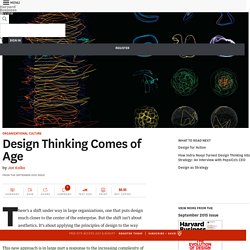
But the shift isn’t about aesthetics. It’s about applying the principles of design to the way people work. This new approach is in large part a response to the increasing complexity of modern technology and modern business. That complexity takes many forms. Sometimes software is at the center of a product and needs to be integrated with hardware (itself a complex task) and made intuitive and simple from the user’s point of view (another difficult challenge). Educator Duo Reflects on How Design Thinking Has Transformed Their Teaching — The Teachers Guild. JOHN: I was very fortunate in two respects concerning my baptism into design thinking. First, when I was hired at Riverpoint the staff had already started using design thinking so I was sent to the Ford Institute for a four day training. Second, my teaching partner (Regan) had already worked extensively with design thinking in the classroom, and her enthusiasm for the d.school at Stanford, and IDEO was infectious.
What this allowed me to do was just sort of jump into using design thinking with staff and students without having to be “sold” on the idea. It was already a cultural value at our school, and Regan had already had great success with it in the past. This was interesting because most of my teaching has been predicated on me searching and finding things to do — after much deliberation usually. I have always tried to be as student-centered as possible. Intersection Of Science & Design Thinking: Are you a HUB of Innovation? — Design Thinking. Design Thinking and ELearning. Instructional designers are tasked with more than creating an elearning course. They are expected to create a course that is effective. The content and the way that it is presented has to fulfill a set of objectives and in many cases elicit some form of measurable change.
Because of this requirement instructional designers think about course content differently than most. Influential Educator Promoted 'Backward Design' High school Principal Pete Steedman begins every school year by telling his staff to read an article by Grant Wiggins titled, "The Futility of Trying to Teach Everything of Importance. " "I love what it said about the choices we make as teachers and how, in the end, the most important thing we can do is ask kids to question," said Steedman, former principal of a charter school in Hyannis, Mass.
Wiggins was an influential educator whose philosophy has influenced thousands of teachers, and he referred to himself as a "professional educational troublemaker of long standing. " He urged teachers to work backwards, from the goals they wanted students to achieve to the knowledge they wanted pupils to acquire, and only then create a curriculum. He called this theory "Backward Design," a concept that has become a mantra for many educators. Grant Wiggins, 64, died on May 26 of a heart attack.
Summer Sessions Week 3: Educator as a Design Thinker. Welcome to the third week of the Heinemann Summer Sessions! Each week throughout the summer, we will feature an article, video clip, or new professional book chapter from the Heinemann Digital Library on the topic of student engagement. Today, we look at an article from Jackie Gerstein titled, "Educator as a Design Thinker," featured on the Heinemann Digital Library. Harness the power of design thinking. If you're looking for the secret to business success, some suggest you should start by forgetting everything you know. How to harness the power of design thinking. By Theo Chapman Design thinking has become the hot new trend that its proponents argue is the secret to successful business performance.
DEEP design thinking - How to harness the power of design thinking. By Theo Chapman. 5 Ways Design Thinking Can Help You Create a Killer Content Strategy. Before Akshay Kothari sold Pulse to LinkedIn for $90 million, he was a reserved electrical engineering grad student at Stanford University. On a whim, he signed up for the introductory Design Thinking Bootcamp at the university’s d.school with his friend and future business partner, computer science grad student Ankit Gupta. The school’s interactive style immediately made Kothari feel … awkward.
“When I first started, I felt like I was in the wrong place,” he said. The next design trend is one that eliminates all choices. Performance wear is typically designed for sports and extreme environments—brutally cold and windy mountain ranges, heat-baked deserts—situations where people actually need their clothing to protect them from the elements without restricting movement. Continuing advances in design, fabric technology, and manufacturing have made these clothes more high-performance than ever. Design thinking holds the answer to some of the public sector’s toughest challenges. In the past few decades, design has become increasingly recognised as a driver of economic growth. What is design thinking? Can it work in my classroom? A Brave New Experiment. Historically, the primary objective of the K12 Lab Network has been to support educators in learning the five phases of the design thinking process in order to build creative confidence, solve school-wide and district-wide issues and teach students to be their own agents of change.
While this approach has been hugely successful, sparking a design thinking movement that has traveled acound the globe, the K12 Lab Network Team wanted to experiment with what might happen if the mindsets which support the design thinking process were taught instead of the process itself. BIAS TOWARDS ACTIONWe’ve just led our first experiment! SAPVoice: What Is Design Thinking? Customer-centric design is about looking out from the inside—rather than outside in. Today’s organizations face multifaceted problems that are part of increasingly complex business models. Continued expansion of global transactions, supported by partnerships that can span large ecosystems, create unique opportunities and unique challenges for businesses.
Design to Personalize: How to Help Teachers and Students Succeed. Mobile Learning's Impact on Instructional Design - Designed:2:Learn. 10 Questions to Ask When Planning Tech Infused Units. Online Safety: A Teacher’s Guide to Dealing with Cyberbullying, Sexting, and Student Privacy. Steps for Applying Design Thinking to Build and Evolve Schools.
Design Thinking, Deconstructed. Square - Street - Home on Architizer. SparkTruck: A "Bookmobile" That Brings Rapid Prototyping to School Kids. Statistic Of The Day: The Myth Of Data-Driven Instruction. Digital Tools for Design Research. How ‘Deprogramming’ Kids From How to ‘Do School’ Could Improve Learning. 6 Design Principles Of Connected Learning. Design Thinking « Design Thinking for Educators. Design Thinking for Educators Toolkit. [INFOGRAPHIC] The ADDIE Model: A Visual Representation. 10 Things Successful eLearning Professionals Do Differently. #edleader21 DesignThinking Wkshop @mvpschool #mvpschool #acps. Design Thinking. Design Thinking. Data visualization. Amazon.
Report of the Task Force on Doctoral Study in Modern Language and Literature (2014) A Defense of Deeper Learning: Watch What's Working, Part 2. Edsurge. Edsurge. Educator as a Design Thinker. What is the legacy of the Education Act, 70 years on? Twitter, Instagram, and Pinterest in the Classroom. Design Minds.